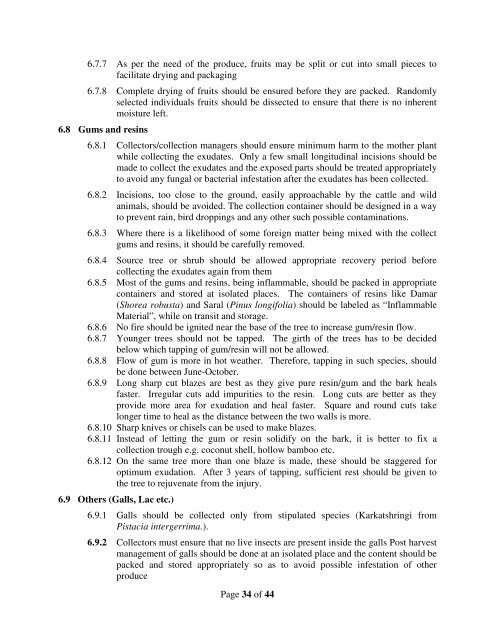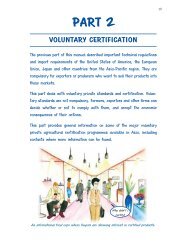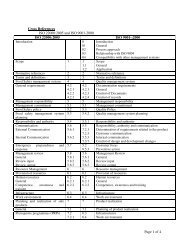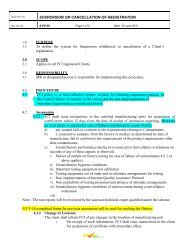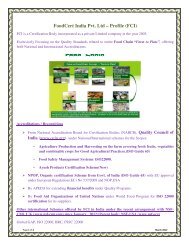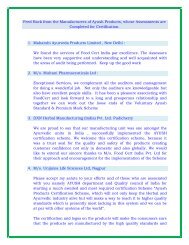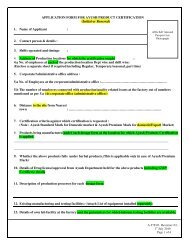Standard for Good Field Collection Practices - NMPB
Standard for Good Field Collection Practices - NMPB
Standard for Good Field Collection Practices - NMPB
Create successful ePaper yourself
Turn your PDF publications into a flip-book with our unique Google optimized e-Paper software.
6.7.7 As per the need of the produce, fruits may be split or cut into small pieces to<br />
facilitate drying and packaging<br />
6.7.8 Complete drying of fruits should be ensured be<strong>for</strong>e they are packed. Randomly<br />
selected individuals fruits should be dissected to ensure that there is no inherent<br />
moisture left.<br />
6.8 Gums and resins<br />
6.8.1 Collectors/collection managers should ensure minimum harm to the mother plant<br />
while collecting the exudates. Only a few small longitudinal incisions should be<br />
made to collect the exudates and the exposed parts should be treated appropriately<br />
to avoid any fungal or bacterial infestation after the exudates has been collected.<br />
6.8.2 Incisions, too close to the ground, easily approachable by the cattle and wild<br />
animals, should be avoided. The collection container should be designed in a way<br />
to prevent rain, bird droppings and any other such possible contaminations.<br />
6.8.3 Where there is a likelihood of some <strong>for</strong>eign matter being mixed with the collect<br />
gums and resins, it should be carefully removed.<br />
6.8.4 Source tree or shrub should be allowed appropriate recovery period be<strong>for</strong>e<br />
collecting the exudates again from them<br />
6.8.5 Most of the gums and resins, being inflammable, should be packed in appropriate<br />
containers and stored at isolated places. The containers of resins like Damar<br />
(Shorea robusta) and Saral (Pinus longifolia) should be labeled as “Inflammable<br />
Material”, while on transit and storage.<br />
6.8.6 No fire should be ignited near the base of the tree to increase gum/resin flow.<br />
6.8.7 Younger trees should not be tapped. The girth of the trees has to be decided<br />
below which tapping of gum/resin will not be allowed.<br />
6.8.8 Flow of gum is more in hot weather. There<strong>for</strong>e, tapping in such species, should<br />
be done between June-October.<br />
6.8.9 Long sharp cut blazes are best as they give pure resin/gum and the bark heals<br />
faster. Irregular cuts add impurities to the resin. Long cuts are better as they<br />
provide more area <strong>for</strong> exudation and heal faster. Square and round cuts take<br />
longer time to heal as the distance between the two walls is more.<br />
6.8.10 Sharp knives or chisels can be used to make blazes.<br />
6.8.11 Instead of letting the gum or resin solidify on the bark, it is better to fix a<br />
collection trough e.g. coconut shell, hollow bamboo etc.<br />
6.8.12 On the same tree more than one blaze is made, these should be staggered <strong>for</strong><br />
optimum exudation. After 3 years of tapping, sufficient rest should be given to<br />
the tree to rejuvenate from the injury.<br />
6.9 Others (Galls, Lac etc.)<br />
6.9.1 Galls should be collected only from stipulated species (Karkatshringi from<br />
Pistacia intergerrima.).<br />
6.9.2 Collectors must ensure that no live insects are present inside the galls Post harvest<br />
management of galls should be done at an isolated place and the content should be<br />
packed and stored appropriately so as to avoid possible infestation of other<br />
produce<br />
Page 34 of 44


